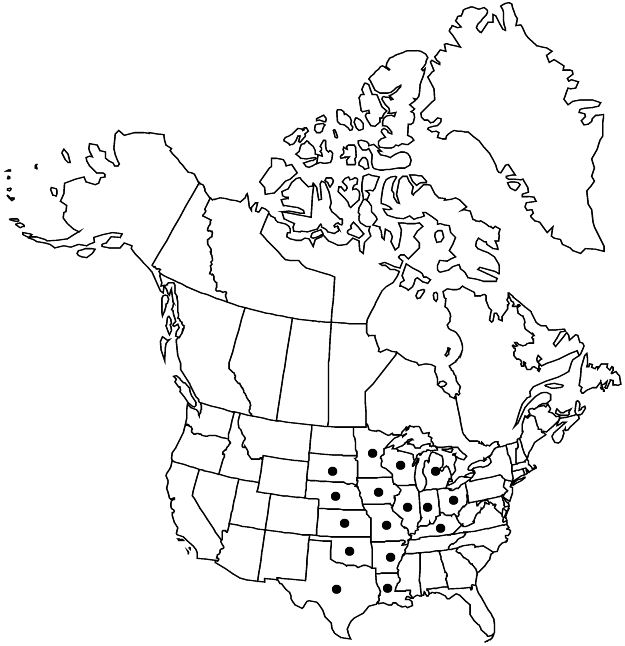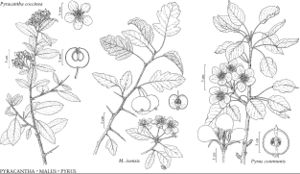Malus ioensis
in N. L. Britton and A. Brown, Ill. Fl. N. U.S. 2: 235. 1897.
Trees, sometimes shrubs, (20–) 40–60 (–100) dm. Stems 6–45 cm diam.; bark dark reddish-brown to gray, with narrow reddish-brown scales, sometimes glaucous when young; young branches reddish gray, tomentose, becoming reddish-brown or dark-brown and glabrous or slightly puberulous; flowering shoots becoming spurs or spiny thorns, 10–60 mm. Buds reddish-brown, ovoid, 3–4 mm, scale margins tomentose. Leaves conduplicate in bud; heteromorphic; stipules deciduous, narrowly lanceolate, 3–8 mm, apex acute; vigorous shoot leaves: petiole 15–30 mm, tomentose; blade ovate, sometimes triangular-ovate or oval, 3–9 (–12) × 1.5–4 (–6) cm, base cuneate to rounded, margins usually lobed, serrate or crenate-serrate, sometimes doubly serrate, apex acute, broadly acute, or rounded, abaxial surface tomentose (villous only on veins), adaxial glabrous or slightly villous; flowering shoot leaves: petiole 5–20 (–25) mm, tomentose, sometimes puberulent; blade elliptic, oval, or ovate, 2–5 × 1–2 cm, base cuneate or rounded, sometimes truncate-rounded, margins lobed or unlobed, serrate, doubly serrate, or crenate-serrate, apex acute, broadly acute, or rounded, abaxial surface usually tomentose, adaxial glabrous. Panicles corymblike; peduncles absent; bracteoles sometimes persistent, filiform, 3–10 mm. Pedicels 15–30 mm, tomentose, sometimes puberulent or sparsely strigose. Flowers fragrant, 35–50 mm diam.; hypanthium tomentose; sepals triangular, 3–7 mm, equal to tube, apex acuminate, surfaces hoary-tomentose; petals pink, sometimes fading white, oblong to narrowly obovate, (11–) 14–20 (–22) mm, claws (2–) 3–4 mm, margins entire, sinuate, or fimbriate, apex rounded; stamens 20, 8–16 mm, anthers rose before dehiscence; styles 5, connate basally, 9–15 mm, ± equal to stamens, tomentose in proximal 1/3. Pomes green, sometimes yellow, depressed-globose, sometimes globose, 20–30 mm diam., greasy, waxy, cores not enclosed at apex; sepals persistent, erect; sclereids abundant surrounding core. Seeds dark-brown. 2n = 34, 51, 64.
Phenology: Flowering Apr–May; fruiting Sep–Oct.
Habitat: Woods, thickets, barrens, hillsides, stream and lake banks, flood plains, roadsides, open fields, fence lines
Elevation: 100–300 m
Distribution

Ark., Ill., Ind., Iowa, Kans., Ky., La., Mich., Minn., Mo., Nebr., Ohio, Okla., S.Dak., Tex., Wis.
Discussion
The fruit of Malus ioensis is extremely acrid in taste, and it has a high pectin content that allows it to be made into a clear yellow jelly. The beautiful, fragrant flowers provide a pleasant show in spring. Double-flowered forms have been selected for cultivation: Bechtel’s crab and forma fimbriata A. D. Slavin. This species flowers later than the cultivated apple in most regions; artificial hybrids have been documented. Malus ×soulardii (L. H. Bailey) Britton (Pyrus ×soulardii L. H. Bailey) is a hybrid between M. ioensis and M. pumila.
Selected References
None.
Lower Taxa
"dm" is not declared as a valid unit of measurement for this property.
